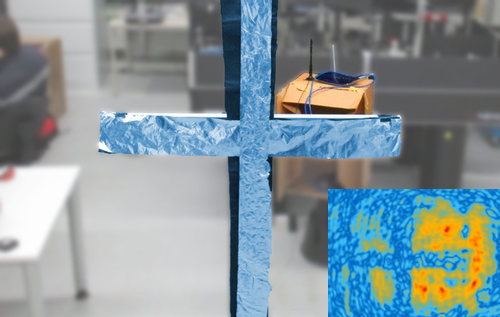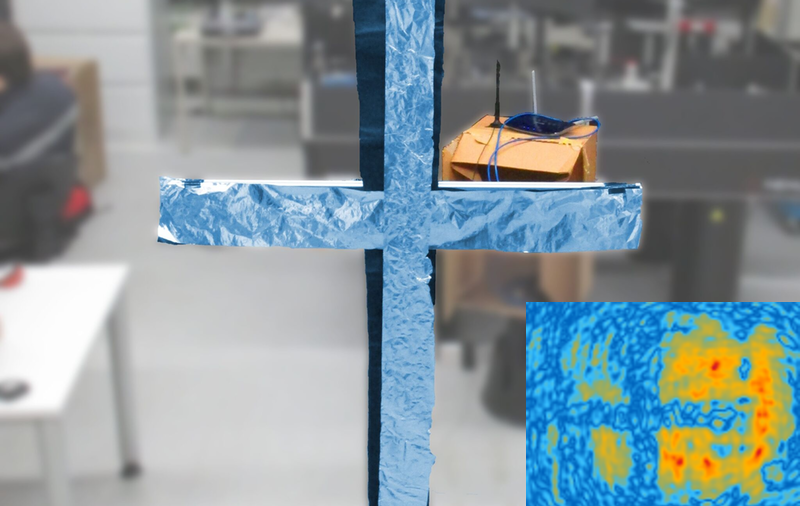Imaging with Your Wi-Fi Hotspot
The radio signals emitted by a commercial Wi-Fi router can act as a kind of radar, providing images of the transmitter’s environment, according to new experiments. Two researchers in Germany borrowed techniques from the field of holography to demonstrate Wi-Fi imaging. They found that the technique could potentially allow users to peer through walls and could provide images 10 times per second.
Wi-Fi imaging is not a new idea. “The past two years have seen an explosion of methods for passive Wi-Fi imaging,” says Philipp Holl, an undergraduate student who worked with Friedemann Reinhard of the Technical University of Munich to develop the new method. The principle is similar to that of standard radar technology, except that radar systems make use of tailor-made emitters that produce a wide range of frequencies (that is, they have wide bandwidths). Wi-Fi imaging, in contrast, would ideally use the relatively narrow bandwidths of commercial Wi-Fi sources.
But the narrow bandwidth, coupled with the presence of multiple reflections from nearby objects, can make it hard to extract an image from the Wi-Fi signal. Previous attempts at Wi-Fi imaging have therefore tended to use specially adapted systems: either short pulses of ultra-wideband signals [1] or highly directional Wi-Fi beams from which images are reconstructed based on the angle of the signal’s arrival [2]. Such approaches have been used to image human figures (including moving people) and metallic devices such as laptops in an office environment [3].
Now Holl and Reinhard have found a way to implement Wi-Fi imaging using a standard, commercial Wi-Fi router, or “hotspot,” despite its narrow bandwidth. The trick was to use all of the Wi-Fi signal that reaches a detector, rather than discarding some of the data, as previous methods have done (for example, by looking only at the angle of arrival). “Because we record all available information—both direct illumination and reflections of the surroundings—our method should be the most accurate for localizing emitters and recognizing objects,” says Holl.
Holl and Reinhard treated the two-dimensional Wi-Fi wave front like a hologram—a 2D encoding of a 3D image. The image was of the 3D environment surrounding the router. They used standard mathematical procedures developed for holographic imaging and for the remote-sensing technique called synthetic aperture radar. The duo also enhanced the contrast by subtracting an image of the emitter alone—like subtracting a bright source from an astronomical image to allow dimmer objects around it to be seen.
For their experiments, Holl and Reinhard used a commercial Wi-Fi transmitter working at a frequency of around 5 GHz. The researchers placed an antenna 2.3 m from the source and moved it to scan across a plane measuring 2m×3m. And in the intervening gap they placed a metal cross that was about 1 m wide. The resulting image revealed the clear outline of the cross. “Wherever your laptop can get a Wi-Fi connection, we can record a hologram with a good signal-to-noise ratio,” says Holl.
To demonstrate the potential of the approach on a larger scale, Holl and Reinhard carried out a computer simulation of the signal they would detect for a small building measuring 20m×17m×12m. The upper floor contained a 3D grid of metal bars that could represent a structure in a storage facility. They then reconstructed a series of 2D slices of the virtual building.
To capture such information in a real experiment, though, one would need a large recording area. “It could be achievable with stationary arrays of antennas, installed, for instance, in the ceiling of a factory,” says Holl. He says these arrays could locate products in a multistory factory. Finding items in a building can already be done using the technology of radio frequency (rf) tagging, but rf tagging doesn’t reveal each product's surroundings. The new method should be able to produce about ten 1000×1000-pixel snapshots per second of a dynamic environment, given the signal strength of a typical Wi-Fi router, the researchers say.
“The results look quite promising,” says electronic engineer Karl Woodbridge of University College London. He thinks the biggest drawback will be the slowness of scanning the antenna, which could make the system impractical. But Holl explains that arrays of antennas could dramatically speed things up. “Even using a single row of antennas, carried, for instance, by a drone or truck, could reduce the recording time to a few seconds.”
This research is published in Physical Review Letters.
–Philip Ball
Philip Ball is a freelance science writer in London. His latest book is How Life Works (Picador, 2024).
References
- Y. Yang and A. E. Fathy, “See-Through-Wall Imaging Using Ultra Wideband Short-Pulse Radar System,” Proc. IEEE Antennas Propag. Soc. Int. Symp. 3B, 334 (2005).
- F. Adib and D. Katabi, “See through Walls with WiFi!,” Proceedings of the ACM SIGCOMM 2013 Conference on SIGCOMM - SIGCOMM '13 (2013).
- D. Huang, R. Nandakumar, and S. Gollakota, “Feasibility and Limits of Wi-Fi Imaging,” Proceedings of the 12th ACM Conference on Embedded Network Sensor Systems - SenSys '14 (2014).





